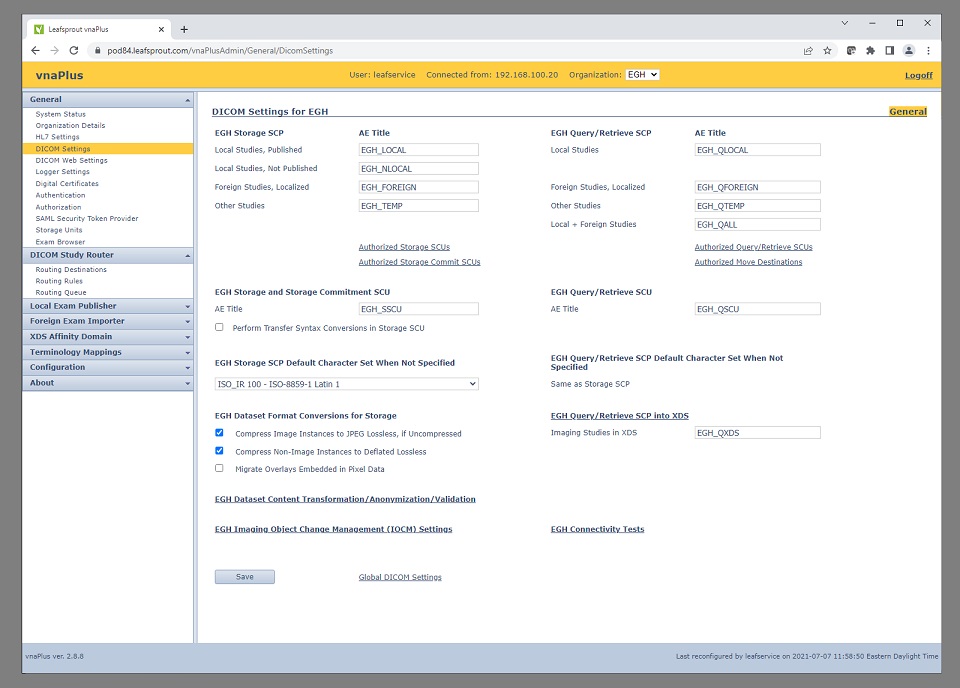vnaPlus
vnaPlus is Leafsprout's Vendor Neutral Archive (VNA) of clinical content, sometimes known as a Diagnostic Image Repository (DIR). It provides long-term storage for a wide range of imaging and imaging-related objects: imaging studies, reports, requisitions, etc.
vnaPlus offers uncompromised adherence to industry standards, all aspects of security, performance and scalability of deployment – from a small clinic to a multi-enterprise setup.
Key Features:

- IHE Image Manager/Archive functionality enhanced with the web-based DICOM interfaces, including: STOW-RS, WADO-URI, WADO-RS, WADO-WS, QIDO-RS.
- All data is archived in a standard format with a standard interface - no proprietary encodings used.
- Multi-tenant architecture for provisioning many independent organizations in a single logical instance/server farm, if needed.
- Configurable Data Lifecycle Management to support information retention policies that are aligned with the jurisdictional requirements and business needs of each tenant.
- Designed for the cloud - either public (Amazon and Azure), private (a datacentre controlled by the enterprise), or hybrid (some services on site, e.g., a cache of exams with the last 6 months of data, and some in the cloud).
- Centralized and federated deployment models available. The latter are for large regions with multiple VNAs.
- Storage units independently assigned to each tenant. This facilitates "Bring Your Own Storage" or "Pay For Your Own Storage" (e.g., using a specific AWS S3 account).
- Support for block-level (SAN), file level (NAS), and object-level (Object Storage Systems like AWS S3 or Azure Blobs) storage units.
- Built-in data replication to configurable number of local or remote storage units (a.k.a. storage replicas). This ensures multiple copies of each object.
- Encryption of all managed objects independent of the storage vendor layer encryption. Each tenant has its own encryption key.
- Support for Image Object Change Management (IOCM) IHE Profile to allow external systems to explicitly adjust the content of imaging studies stored in the VNA, e.g., to hide or delete instances due to incorrect modality worklist selection, quality reasons, patient safety reasons, or data retention expiry.
- Support for encounter-based imaging (no order present).
- Management and storage of workflow-related and administrative information (orders, reports, patient feeds, etc.) independently for each tenant. This includes a workflow manager that keeps track of open orders and their state transitions.
- Built-in prefetcher of relevant priors (into associated PACS) based on configurable rules [optional].
- Cross-referencing of MRNs via integration with a Master Patient Index system.
- Normalization of foreign/external MRNs, accession numbers, terminology (e.g., procedure codes, body parts) to the environment of a local enterprise.
- Flexible access authorization policies and ATNA-compliant audit trails for HIPAA compliance.
- Available lossless compression of imaging content.
- De-identification of imaging data according to the HIPAA Privacy Rule 164.514 (for research, etc).
- Time Zone and Character Set configurable for each tenant.
- Support for single-byte and multi-byte DICOM charater sets.
- Built-in XDS Document Repository for handling a wide range of content types [optional].
- Built-in XDS Document Source and Imaging Document Source for registering content in XDS systems and serving content to XDS clients [optional].
- Patient, exam, report and order explorer to view any content managed by the archive.
- Administration via a web-based client (see screenshot below).
